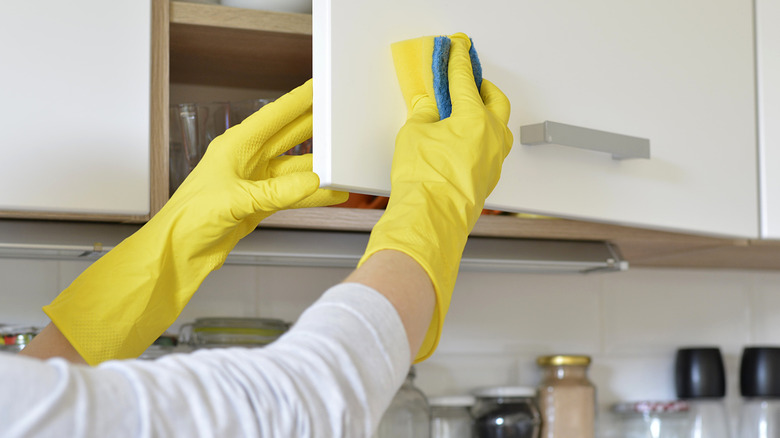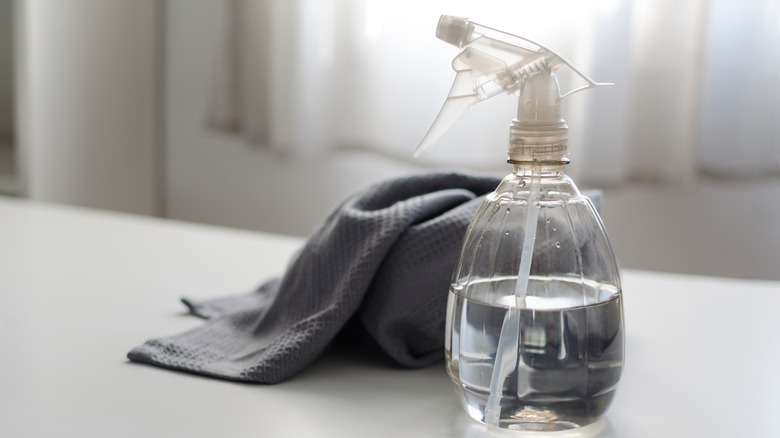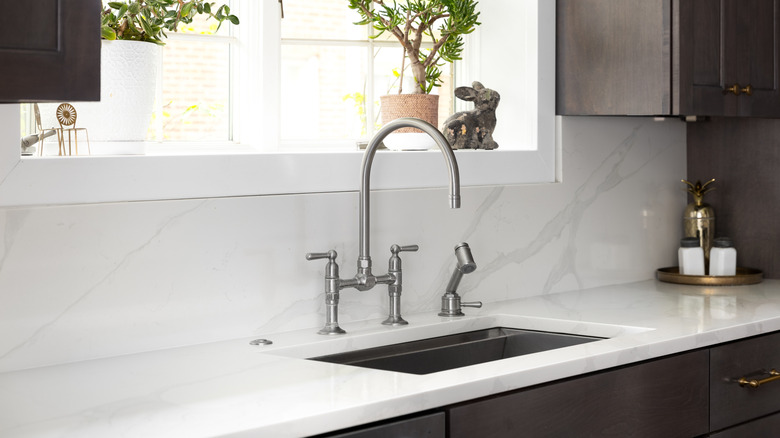Kitchen Cabinet Types You Should Clean With Vinegar (And One Type You Never Should)
Vinegar can be a versatile cleaning tool for tons of different surfaces. Because of its relatively high level of acidity, it's great for breaking down tough stains and grime, and can kill some bacteria and pathogens (but not all). It even carries the added benefit helping to deodorize spaces. And if you're looking for a natural solution for sparkling clean surfaces, it's a much simpler product than standard store-bought cleaners. If you consider the fact that most people already have a bottle of vinegar in their pantry, it's no wonder this product is such a commonly recommended solution for cleaning woes. Just because it's natural, it doesn't mean that vinegar is safe on all surfaces. While a vinegar-and-water solution is great for cleaning laminate cabinets or painted wood cabinets, the high level of acidity can damage the finish on wood cabinets treated with a sealant.
If you're unsure if vinegar is safe to use on your surfaces, always err on the side of caution. This can mean foregoing this option altogether in favor of something more gentle, or performing a patch test when trying to get through stubborn grease. Mix up vinegar and water in a bowl following the ratio you plan to use, then apply it to an inconspicuous spot on your cabinet — preferably the back side of the door or the underside of the unit. Let it sit for a few minutes, then check and see if it caused any damage to the finish. If it didn't, you should be good to go.
How to use vinegar to clean your cabinets
Whenever you use a powerful product like vinegar to clean cabinets, your first step should be dilution. Full-strength vinegar is quite acidic, so a little bit goes a long way. If you're working with regular distilled white vinegar, the general recommendation is to mix it 50/50 with water to create a cleaning solution. This will ensure it has plenty of cleaning power, but it's not so acidic that it damages the surface you're wiping down. If you're using cleaning vinegar, it could be beneficial to increase the percentage of water in your mix, as this product contains a slightly higher concentration of acetic acid than regular white vinegar.
From there, use it like you would any other cleaner. Perform a patch test, if needed, then apply your mixture directly to a rag, pour it into a spray bottle, or fill a soap-dispensing scrub brush. This is also the point where you can get creative with add-ins. There are plenty of scents you can use in DIY cleaning products to give them a more pleasant smell. Considering vinegar's distinct odor, a few drops of your favorite essential oil might be just what you need to level up your mix. For an extra punch of degreasing power, you can add a few squirts of dish soap to your cabinet-cleaning solution.
Additional considerations for cleaning with vinegar
Even if it's safe to clean your cabinets with a vinegar solution, you should take the other items in your kitchen into consideration. Countertops made of natural stone like granite, marble, and travertine should not come into contact with acidic cleaners, as they can dull the shine and degrade the sealant with repeated contact. Even if you're not spraying vinegar directly onto your countertops, errant drips from your cabinets while you're cleaning could result in unintentional damage over time. The same goes for grout, which is important to consider when it comes to flooring and any backsplashes. If these materials are immediately next to your cabinets, it's probably best to stick to a milder cleaner.
Vinegar also has the ability to break down rubber. While this might not seem like a major cause for concern, there are plenty of small rubber components around your kitchen that are likely in close contact with your cabinets. The seal on your dishwasher, for example, can start to corrode with repeated exposure to acidic cleaners. Silicone sealants, like those frequently used around the edges of the sink, can also start to break down after repeated cleanings with, or long-term exposure to, vinegar-based cleaners. By keeping these things in mind, you can be sure your cleaning routine is both effective and safe for all of the materials in your kitchen.


